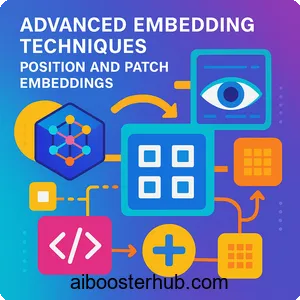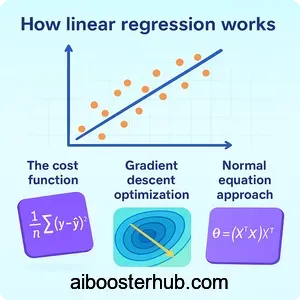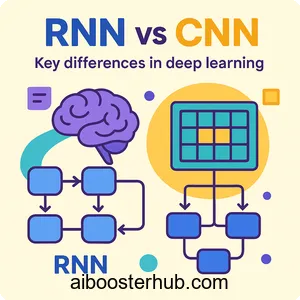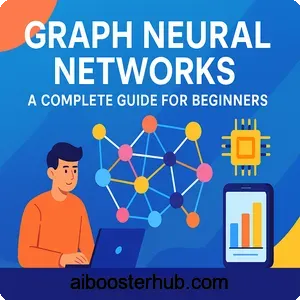Advanced Embedding Techniques: Position and Patch Embeddings
When building modern neural networks, particularly transformers and vision models, understanding how to effectively encode positional information and process visual data becomes crucial. While basic embedding layers handle token representations well, advanced techniques like positional embedding, patch embedding, and rotary position embedding (RoPE) have revolutionized how we build AI systems. This article explores these sophisticated approaches that form the foundation of state-of-the-art models.

Content
Toggle1. Understanding the fundamentals of embeddings
At their core, vector embeddings transform discrete tokens or features into continuous vector representations that neural networks can process. An embedding layer serves as the bridge between symbolic data (words, image patches, or other discrete units) and the numerical vectors that flow through neural network architectures.
Think of embeddings as a translator that converts human-readable information into a language that machines understand. When you input the word “cat” into a language model, the embedding layer doesn’t just assign it a random number—it places it in a high-dimensional space where similar concepts cluster together. Words like “dog,” “pet,” and “kitten” would occupy nearby positions in this space, capturing semantic relationships.
The beauty of embeddings lies in their learned nature. During training, the neural network adjusts these vector representations to optimize performance on the target task. This means the embedding layer doesn’t just memorize assignments; it discovers meaningful patterns that help the model make better predictions.
Basic embedding implementation
Let’s start with a simple example using a pytorch embedding layer:
import torch
import torch.nn as nn
# Create an embedding layer
# vocab_size: number of unique tokens
# embedding_dim: size of each embedding vector
vocab_size = 10000
embedding_dim = 512
embedding_layer = nn.Embedding(vocab_size, embedding_dim)
# Example: embed a sequence of token indices
token_indices = torch.tensor([45, 123, 789, 2341])
embedded_tokens = embedding_layer(token_indices)
print(f"Input shape: {token_indices.shape}") # torch.Size([4])
print(f"Output shape: {embedded_tokens.shape}") # torch.Size([4, 512])
This basic embedding layer works well for many tasks, but it has a critical limitation: it treats all positions in a sequence identically. The word “cat” at the beginning of a sentence gets the exact same representation as “cat” at the end. For many tasks, especially in natural language processing and sequence modeling, position matters enormously.
2. Position embedding: Giving sequences spatial awareness
The transformer architecture famously lacks an inherent sense of order—without positional information, it treats input as an unordered set. This is where position embedding becomes essential. By adding positional information to token embeddings, we enable the model to understand that “The cat chased the dog” means something entirely different from “The dog chased the cat.”
Learned positional embeddings
The most straightforward approach involves learning positional embeddings just like we learn token embeddings. We create a separate embedding layer where each position index maps to a trainable vector:
class LearnedPositionEmbedding(nn.Module):
def __init__(self, max_seq_length, embedding_dim):
super().__init__()
self.token_embedding = nn.Embedding(vocab_size, embedding_dim)
self.position_embedding = nn.Embedding(max_seq_length, embedding_dim)
def forward(self, token_ids):
batch_size, seq_length = token_ids.shape
# Get token embeddings
token_embeds = self.token_embedding(token_ids)
# Create position indices [0, 1, 2, ..., seq_length-1]
positions = torch.arange(seq_length, device=token_ids.device)
positions = positions.unsqueeze(0).expand(batch_size, -1)
# Get position embeddings
position_embeds = self.position_embedding(positions)
# Combine token and position embeddings
return token_embeds + position_embeds
# Usage example
max_length = 512
model = LearnedPositionEmbedding(max_length, embedding_dim)
# Process a batch of sequences
batch_tokens = torch.randint(0, vocab_size, (8, 128)) # 8 sequences, length 128
output = model(batch_tokens)
print(f"Output shape: {output.shape}") # torch.Size([8, 128, 512])
This approach is simple and effective, allowing the neural network to learn whatever positional patterns prove most useful during training. However, it has a fixed maximum sequence length—you can’t process sequences longer than what you specified during initialization.
Sinusoidal embedding
The original transformer paper introduced sinusoidal embedding, an elegant solution that uses fixed mathematical functions to encode positions. The key insight is using sine and cosine functions of different frequencies:
$$ PE_{(pos, 2i)} = \sin\left(\frac{pos}{10000^{2i/d}}\right) $$
$$ PE_{(pos, 2i+1)} = \cos\left(\frac{pos}{10000^{2i/d}}\right) $$
where \(pos\) is the position, \(i\) is the dimension index, and \(d\) is the embedding dimension.
Why does this work so well? The sinusoidal pattern creates a unique “fingerprint” for each position while maintaining useful mathematical properties. Positions that are close together have similar embeddings, and the model can easily learn to attend to relative positions through linear combinations.
Here’s a practical implementation:
import math
class SinusoidalPositionEmbedding(nn.Module):
def __init__(self, embedding_dim, max_seq_length=5000):
super().__init__()
self.embedding_dim = embedding_dim
# Create position encoding matrix
pe = torch.zeros(max_seq_length, embedding_dim)
position = torch.arange(0, max_seq_length, dtype=torch.float).unsqueeze(1)
# Compute the divisors for the sinusoidal functions
div_term = torch.exp(
torch.arange(0, embedding_dim, 2).float() *
(-math.log(10000.0) / embedding_dim)
)
# Apply sin to even indices
pe[:, 0::2] = torch.sin(position * div_term)
# Apply cos to odd indices
pe[:, 1::2] = torch.cos(position * div_term)
# Register as buffer (not a parameter, but moves with model)
self.register_buffer('pe', pe.unsqueeze(0))
def forward(self, x):
# x shape: (batch_size, seq_length, embedding_dim)
seq_length = x.size(1)
return x + self.pe[:, :seq_length, :]
# Example usage
token_embeds = torch.randn(8, 128, 512) # batch of embedded tokens
pos_encoder = SinusoidalPositionEmbedding(512)
output = pos_encoder(token_embeds)
The beauty of sinusoidal embedding is its ability to generalize to sequence lengths not seen during training. The mathematical properties also allow the model to learn relative positions easily—attending to “5 positions ahead” becomes a learnable linear transformation.
3. Rotary position embedding (RoPE): A modern breakthrough
While traditional positional embeddings add information, rotary position embedding (RoPE) takes a fundamentally different approach by rotating the embedding vectors. This technique has gained immense popularity in modern language models because it naturally encodes both absolute and relative position information through geometric transformations.
The core concept
Instead of adding positional information, RoPE applies a rotation matrix to the query and key vectors in the attention mechanism. For a 2D case, imagine rotating a vector by an angle that depends on its position:
$$ \begin{pmatrix} x’ \ y’ \end{pmatrix} = \begin{pmatrix} \cos\theta & -\sin\theta \ \sin\theta & \cos\theta \end{pmatrix} \begin{pmatrix} x \ y \end{pmatrix} $$
where \(\theta = m\cdot\theta_i\), \(m\) is the position, and \(\theta_i\) depends on the dimension.
For higher dimensions, RoPE applies this rotation to pairs of dimensions. The angle for each pair depends on both the position and a base frequency:
$$ \theta_i = 10000^{-2i/d} $$
where \(i\) is the dimension pair index and \(d\) is the total dimension.
Implementing RoPE in PyTorch
Here’s a practical implementation that you can use in your own transformer embeddings:
class RotaryPositionEmbedding(nn.Module):
def __init__(self, dim, max_seq_length=2048, base=10000):
super().__init__()
self.dim = dim
self.max_seq_length = max_seq_length
self.base = base
# Precompute the frequency tensor
inv_freq = 1.0 / (base ** (torch.arange(0, dim, 2).float() / dim))
self.register_buffer('inv_freq', inv_freq)
# Precompute cos and sin values
self._build_cache(max_seq_length)
def _build_cache(self, seq_length):
# Create position indices
t = torch.arange(seq_length, dtype=self.inv_freq.dtype)
# Compute frequencies for each position
freqs = torch.einsum('i,j->ij', t, self.inv_freq)
# Concatenate to match dimension pairs
emb = torch.cat((freqs, freqs), dim=-1)
self.register_buffer('cos_cached', emb.cos())
self.register_buffer('sin_cached', emb.sin())
def rotate_half(self, x):
# Split the last dimension and rotate
x1, x2 = x.chunk(2, dim=-1)
return torch.cat((-x2, x1), dim=-1)
def forward(self, x, seq_length=None):
if seq_length is None:
seq_length = x.shape[-2]
# Get cached cos and sin values
cos = self.cos_cached[:seq_length, :]
sin = self.sin_cached[:seq_length, :]
# Apply rotation
return (x * cos) + (self.rotate_half(x) * sin)
# Example in attention context
class AttentionWithRoPE(nn.Module):
def __init__(self, embed_dim, num_heads):
super().__init__()
self.num_heads = num_heads
self.head_dim = embed_dim // num_heads
self.qkv_proj = nn.Linear(embed_dim, 3 * embed_dim)
self.rope = RotaryPositionEmbedding(self.head_dim)
self.out_proj = nn.Linear(embed_dim, embed_dim)
def forward(self, x):
batch_size, seq_length, embed_dim = x.shape
# Project to Q, K, V
qkv = self.qkv_proj(x)
qkv = qkv.reshape(batch_size, seq_length, 3, self.num_heads, self.head_dim)
qkv = qkv.permute(2, 0, 3, 1, 4) # (3, batch, heads, seq, head_dim)
q, k, v = qkv[0], qkv[1], qkv[2]
# Apply RoPE to queries and keys
q = self.rope(q)
k = self.rope(k)
# Compute attention (simplified)
attn = torch.matmul(q, k.transpose(-2, -1)) / math.sqrt(self.head_dim)
attn = torch.softmax(attn, dim=-1)
out = torch.matmul(attn, v)
out = out.transpose(1, 2).reshape(batch_size, seq_length, embed_dim)
return self.out_proj(out)
Why RoPE excels
The elegance of rotary position embedding lies in its properties. When you compute attention between two tokens, the dot product between their rotated embeddings naturally encodes their relative distance. This happens automatically through the mathematics of rotation—two vectors rotated by angles \(\theta_m\) and \(\theta_n\) will have a dot product that depends on \(\theta_{m-n}\), capturing relative position.
Additionally, RoPE doesn’t add extra parameters and generalizes better to longer sequences than learned positional embeddings. Many cutting-edge language models have adopted this approach for these exact reasons.
4. Patch embedding: Bridging vision and transformers
While positional embeddings solve the sequence ordering problem, computer vision presents a different challenge: how do we feed images into transformer architectures that expect sequences of vectors? Patch embedding provides an elegant solution by treating images as sequences of visual “tokens.”
The core idea
Instead of processing pixels individually, patch embedding divides an image into fixed-size patches (typically 16×16 pixels), flattens each patch, and projects it into an embedding vector. An image of size 224×224 pixels with 16×16 patches becomes a sequence of 196 patch tokens.
This approach transforms the 2D spatial structure of images into the 1D sequential structure that transformers expect, while preserving local visual information within each patch.
Implementing patch embeddings
class PatchEmbedding(nn.Module):
def __init__(self, img_size=224, patch_size=16, in_channels=3, embed_dim=768):
super().__init__()
self.img_size = img_size
self.patch_size = patch_size
self.num_patches = (img_size // patch_size) ** 2
# Convolutional layer to extract patches and embed them
# This is equivalent to splitting into patches and linear projection
self.projection = nn.Conv2d(
in_channels,
embed_dim,
kernel_size=patch_size,
stride=patch_size
)
def forward(self, x):
# x shape: (batch_size, channels, height, width)
batch_size = x.shape[0]
# Apply convolution to create patch embeddings
# Output shape: (batch_size, embed_dim, num_patches_h, num_patches_w)
x = self.projection(x)
# Flatten spatial dimensions
# Shape: (batch_size, embed_dim, num_patches)
x = x.flatten(2)
# Transpose to get sequence format
# Shape: (batch_size, num_patches, embed_dim)
x = x.transpose(1, 2)
return x
# Complete vision transformer input processing
class VisionTransformerInput(nn.Module):
def __init__(self, img_size=224, patch_size=16, in_channels=3,
embed_dim=768, num_classes=1000):
super().__init__()
self.patch_embed = PatchEmbedding(img_size, patch_size, in_channels, embed_dim)
num_patches = self.patch_embed.num_patches
# Learnable class token (for classification)
self.cls_token = nn.Parameter(torch.zeros(1, 1, embed_dim))
# Positional embeddings (including cls token)
self.pos_embed = nn.Parameter(torch.zeros(1, num_patches + 1, embed_dim))
def forward(self, x):
batch_size = x.shape[0]
# Get patch embeddings
x = self.patch_embed(x)
# Expand cls token for batch
cls_tokens = self.cls_token.expand(batch_size, -1, -1)
# Concatenate cls token
x = torch.cat((cls_tokens, x), dim=1)
# Add positional embeddings
x = x + self.pos_embed
return x
# Example usage
model = VisionTransformerInput(img_size=224, patch_size=16, embed_dim=768)
# Process a batch of images
images = torch.randn(4, 3, 224, 224) # 4 RGB images
output = model(images)
print(f"Output shape: {output.shape}") # torch.Size([4, 197, 768])
# 197 = 1 (cls token) + 196 (14x14 patches)
Advanced patch embedding strategies
Modern vision models have explored various refinements to basic patch embedding:
Overlapping patches: Instead of non-overlapping patches, some models use a sliding window approach with stride smaller than the patch size. This creates smoother transitions between patches:
class OverlappingPatchEmbedding(nn.Module):
def __init__(self, img_size=224, patch_size=16, stride=8,
in_channels=3, embed_dim=768):
super().__init__()
self.projection = nn.Conv2d(
in_channels,
embed_dim,
kernel_size=patch_size,
stride=stride, # Smaller stride creates overlap
padding=(patch_size - stride) // 2
)
# Calculate number of patches with overlap
self.num_patches = ((img_size - patch_size) // stride + 1) ** 2
def forward(self, x):
x = self.projection(x)
x = x.flatten(2).transpose(1, 2)
return x
Hierarchical patching: Some architectures use different patch sizes at different stages, similar to convolutional neural networks. This creates a multi-scale representation:
class HierarchicalPatchEmbedding(nn.Module):
def __init__(self, img_size=224, patch_sizes=[4, 8, 16],
embed_dims=[192, 384, 768], in_channels=3):
super().__init__()
self.stages = nn.ModuleList()
current_dim = in_channels
current_size = img_size
for patch_size, embed_dim in zip(patch_sizes, embed_dims):
stage = nn.Sequential(
nn.Conv2d(current_dim, embed_dim,
kernel_size=patch_size, stride=patch_size),
nn.LayerNorm([embed_dim, current_size // patch_size,
current_size // patch_size])
)
self.stages.append(stage)
current_dim = embed_dim
current_size = current_size // patch_size
def forward(self, x):
features = []
for stage in self.stages:
x = stage(x)
features.append(x)
return features
5. Combining techniques for optimal performance
The real power emerges when we intelligently combine these embedding techniques. Modern architectures carefully orchestrate positional embeddings, patch embeddings, and attention mechanisms to achieve state-of-the-art results.
Hybrid vision transformers
Consider a vision transformer that uses patch embeddings with RoPE for improved spatial reasoning:
class HybridVisionTransformer(nn.Module):
def __init__(self, img_size=224, patch_size=16, embed_dim=768,
num_heads=12, depth=12):
super().__init__()
# Patch embedding
self.patch_embed = PatchEmbedding(img_size, patch_size, 3, embed_dim)
# RoPE for better relative position encoding
head_dim = embed_dim // num_heads
self.rope = RotaryPositionEmbedding(head_dim)
# Learnable 2D positional embeddings as bias
num_patches = self.patch_embed.num_patches
grid_size = int(num_patches ** 0.5)
self.pos_embed_2d = nn.Parameter(
torch.zeros(1, grid_size, grid_size, embed_dim)
)
# Transformer blocks would go here
self.cls_token = nn.Parameter(torch.zeros(1, 1, embed_dim))
def interpolate_pos_encoding(self, x, h, w):
# Allow processing different image sizes
npatch = x.shape[1] - 1 # subtract cls token
N = self.pos_embed_2d.shape[1]
if npatch == N * N and h == w:
return self.pos_embed_2d
# Interpolate position embeddings
patch_pos_embed = self.pos_embed_2d
dim = x.shape[-1]
patch_pos_embed = nn.functional.interpolate(
patch_pos_embed.reshape(1, N, N, dim).permute(0, 3, 1, 2),
size=(h, w),
mode='bicubic',
)
return patch_pos_embed.permute(0, 2, 3, 1)
def forward(self, x):
batch_size = x.shape[0]
# Patch embedding
x = self.patch_embed(x)
# Calculate grid size
num_patches = x.shape[1]
grid_size = int(num_patches ** 0.5)
# Add 2D positional embeddings
pos_embed = self.interpolate_pos_encoding(x, grid_size, grid_size)
pos_embed = pos_embed.reshape(1, -1, x.shape[-1])
x = x + pos_embed
# Add cls token
cls_tokens = self.cls_token.expand(batch_size, -1, -1)
x = torch.cat((cls_tokens, x), dim=1)
return x
Multi-modal embeddings
When building models that process both text and images, combining different embedding strategies becomes crucial:
class MultiModalEmbedding(nn.Module):
def __init__(self, vocab_size=50000, img_size=224, patch_size=16,
embed_dim=768, max_text_length=512):
super().__init__()
# Text embeddings with learned positions
self.text_token_embed = nn.Embedding(vocab_size, embed_dim)
self.text_pos_embed = nn.Embedding(max_text_length, embed_dim)
# Vision embeddings with patches
self.vision_patch_embed = PatchEmbedding(
img_size, patch_size, 3, embed_dim
)
# Modality type embeddings
self.modality_embed = nn.Embedding(2, embed_dim) # 0: text, 1: vision
# RoPE for better cross-modal attention
self.rope = RotaryPositionEmbedding(embed_dim // 12) # assuming 12 heads
def forward(self, text_ids=None, images=None):
embeddings = []
modality_ids = []
if text_ids is not None:
# Process text
batch_size, seq_len = text_ids.shape
text_embeds = self.text_token_embed(text_ids)
positions = torch.arange(seq_len, device=text_ids.device)
positions = positions.unsqueeze(0).expand(batch_size, -1)
text_embeds = text_embeds + self.text_pos_embed(positions)
embeddings.append(text_embeds)
modality_ids.append(torch.zeros(batch_size, seq_len,
dtype=torch.long,
device=text_ids.device))
if images is not None:
# Process images
batch_size = images.shape[0]
img_embeds = self.vision_patch_embed(images)
num_patches = img_embeds.shape[1]
embeddings.append(img_embeds)
modality_ids.append(torch.ones(batch_size, num_patches,
dtype=torch.long,
device=images.device))
# Concatenate all embeddings
all_embeds = torch.cat(embeddings, dim=1)
all_modality_ids = torch.cat(modality_ids, dim=1)
# Add modality embeddings
modality_embeds = self.modality_embed(all_modality_ids)
all_embeds = all_embeds + modality_embeds
return all_embeds
Performance considerations
When implementing these techniques in production, several factors affect performance:
Memory usage: Positional embeddings add minimal overhead, but patch embeddings with large images can be memory-intensive. Consider using gradient checkpointing for deep models:
from torch.utils.checkpoint import checkpoint
class EfficientTransformerBlock(nn.Module):
def __init__(self, embed_dim, num_heads):
super().__init__()
self.attention = AttentionWithRoPE(embed_dim, num_heads)
self.ffn = nn.Sequential(
nn.Linear(embed_dim, 4 * embed_dim),
nn.GELU(),
nn.Linear(4 * embed_dim, embed_dim)
)
self.norm1 = nn.LayerNorm(embed_dim)
self.norm2 = nn.LayerNorm(embed_dim)
def forward(self, x):
# Use checkpoint to save memory
x = x + checkpoint(self.attention, self.norm1(x))
x = x + checkpoint(self.ffn, self.norm2(x))
return x
Computational efficiency: RoPE requires careful implementation to avoid redundant calculations. Cache the frequency tensors and reuse them across batches.
6. Practical tips and best practices
After exploring these techniques theoretically and seeing their implementations, let’s discuss practical considerations for using them effectively in your own projects.
Choosing the right embedding strategy
For language models: RoPE has become the de facto standard for new architectures due to its excellent extrapolation properties. If you’re building a model that might need to handle sequences longer than those seen during training, RoPE is your best choice. For shorter, fixed-length sequences, learned positional embeddings work perfectly fine and are simpler to implement.
For vision models: Patch embedding with learned 2D positional embeddings remains the standard approach. The key decision is choosing the patch size—smaller patches capture finer details but increase computational cost quadratically. A 16×16 patch size offers a good balance for most applications.
For multi-modal models: Combine techniques thoughtfully. Use separate embedding strategies optimized for each modality, then add modality-specific biases or tokens to help the model distinguish between different input types.
Common pitfalls and solutions
Problem: Position embeddings not generalizing to longer sequences.
Solution: Use RoPE or sinusoidal embeddings, which have better extrapolation properties than learned embeddings.
Problem: Out-of-memory errors with high-resolution images.
Solution: Use hierarchical patch embedding or increase the patch size. You can also process images in multiple crops and aggregate features.
Problem: Poor performance on downstream tasks.
Solution: Make sure to fine-tune positional embeddings when adapting pre-trained models to different sequence lengths or input sizes. Don’t freeze these parameters too early.
Debugging embedding layers
When your model isn’t learning properly, embedding layers are often overlooked. Here are diagnostic techniques:
def diagnose_embeddings(model, dataloader):
"""Check if embeddings are learning meaningful representations"""
model.eval()
embeddings = []
labels = []
with torch.no_grad():
for batch_data, batch_labels in dataloader:
# Extract embeddings from your model's embedding layer
embeds = model.get_embeddings(batch_data)
embeddings.append(embeds.cpu())
labels.append(batch_labels.cpu())
embeddings = torch.cat(embeddings, dim=0)
labels = torch.cat(labels, dim=0)
# Compute average distance between embeddings of same vs different classes
same_class_dist = []
diff_class_dist = []
for i in range(len(labels)):
for j in range(i + 1, len(labels)):
dist = torch.norm(embeddings[i] - embeddings[j])
if labels[i] == labels[j]:
same_class_dist.append(dist.item())
else:
diff_class_dist.append(dist.item())
print(f"Average same-class distance: {sum(same_class_dist)/len(same_class_dist):.4f}")
print(f"Average different-class distance: {sum(diff_class_dist)/len(diff_class_dist):.4f}")
# Good embeddings should show lower same-class distance
Optimization and training strategies
Initialize positional embeddings carefully. For learned embeddings, use small random initialization. For sinusoidal embeddings, ensure your implementation matches the theoretical formulation exactly—off-by-one errors in position indices can severely harm performance.
When training, consider using a warmup schedule specifically for embedding layers. They often benefit from starting with a lower learning rate:
# Create separate parameter groups
embedding_params = [p for n, p in model.named_parameters() if 'embed' in n]
other_params = [p for n, p in model.named_parameters() if 'embed' not in n]
optimizer = torch.optim.AdamW([
{'params': embedding_params, 'lr': 1e-4},
{'params': other_params, 'lr': 1e-3}
])
7. Conclusion
Advanced embedding techniques represent the foundational layer that enables modern neural networks to process sequential and spatial data effectively. From the elegant mathematics of sinusoidal encoding to the geometric insights of rotary position embedding, and from simple patch extraction to sophisticated multi-modal fusion, these methods give our models the spatial and sequential awareness they need to excel.
The key insight across all these techniques is that proper encoding of positional and structural information is not just a technical detail—it’s fundamental to how neural networks understand the world. Whether you’re building language models, vision transformers, or multi-modal systems, choosing and implementing the right embedding strategy will significantly impact your model’s performance and capabilities. Start with the implementations provided here, experiment with combinations that suit your specific use case, and don’t hesitate to innovate on these foundations as you push the boundaries of what’s possible with AI.









